The Bar Prep Guide
September 18, 2023

What is the Multistate Essay Exam (MEE)?
The Multistate Essay Exam or the MEE is just one of three components of the Uniform Bar Exam . It is the essay portion of the bar exam. You can expect to see this on the first day (Tuesday) of the exam during the afternoon session.
While every jurisdiction administers an essay portion on their bar exam, the 41 states that use the UBE have an MEE component. It is the section of the exam where you get to use the legal writing skills that you picked up in law school to write six essays that make up 30% of your overall UBE score.
The Uniform Bar Exam uses the same essays and multiple choice questions in every jurisdiction, so the essays you will see on the Uniform Bar Exam do not test your jurisdiction’s law. Rather, they focus on federal law and general rules. That means that any bar prep course that focuses on the UBE will be able to adequately prepare you for the MEE on the bar exam.
This article breaks down what you can expect on the MEE, tips for studying for the MEE, and all of the most frequently tested MEE rules based on past exams.
MEE Subjects
Before you start to prepare for the Multistate essay exam, it’s helpful to know exactly what to expect from it.
The MEE topics include everything tested on the MBE and a few additional subjects. For that reason, this is the most intimidating component of the bar exam for many test takers. Fortunately, with the right study method, you can pass the MEE.
The MEE subjects include:
- Agency and Partnerships
- Corporations
- Civil Procedure
- Conflict of Laws
- Constitutional Law
- Criminal Law and Procedure
- Real Property
- Secured Transactions
How to Study for the MEE
Figuring out how to study for the bar exam and prepare for the Multistate Essay Exam efficiently is one of the most important things you can do. There is so much information tested on the exam that you have to find time efficient ways to prepare for each section of the exam.
While your bar prep course will include modules and activities to prepare you for the bar exam essays, it’s helpful to have a personal strategy for attacking this part of the exam.
Know What to Expect on the Multistate Essay Exam
As we discussed above, this essay section of the bar exam tests 14 different subjects. You can expect to see six essays on your exam which means that not all of those MEE subjects will be tested on your exam.
While you will inevitably spend time preparing for topics that will not be tested on your bar exam, you can make the most of your study time by focusing on the subjects that you are guaranteed to see on the exam.
These include the seven MBE subjects that can also appear on the Multistate Essay Exam. You will likely see three to four questions that test MBE subjects, so all of your preparation for the MBE will carry over into the MEE.
Memorize the Most Frequently Tested MEE Rules
Now that you can rest easy knowing that your MBE preparation will help you on the Multistate Essay Exam, here is another tip that will help reduce your essay-related anxiety. You can review past essays and find patterns in the rules and fact patterns that are most often tested.
In fact, you can download a guide to the most frequently tested MEE rules here . This includes not only a list of the rules but also the rules written out for you so you don’t have to comb through your outlines to find them.
Review Past Bar Exam Essays
Reviewing past bar exam essays is arguably one of the best ways to study for this component of the exam. Not only should you be testing your ability to spot issues within the fact pattern and re-write the rules, but you should also review the answers that received the highest score.
The bar examiners are not looking for the perfect answer to each question tested on the MEE. Instead, they are looking for the best answer written on that exam day. That means that you just need to have a more comprehensive and well-written answer than most of your fellow test takers.
By reading past exams and answers, practicing outlining and writing out your own answers, and memorizing the frequently tested MEE rules, you will put yourself in the best position to pass the MEE.
You can see past MEE questions and answers on the NCBE website.
Structure Your Essay Properly
Now that you know you’re not striving for a perfect answer, you can focus on practicing the proper essay format. Just like your law school professors expected you to structure your final exam essays using IRAC or CREAC, the bar examiners expect the same.
Basically, you want to make sure that your responses are as easy to read as possible. Your answer should:
- Identify the issue
- State the rule that applies
- Analyze and apply the rule against the fact pattern
- State a logical conclusion
Notice that you do not have to come to the right conclusion. You should need to state a conclusion that makes sense based on your analysis. This section of the bar exam is testing your ability to memorize and apply rules, so keep that in mind.
Make Sure Your Answers Are Easy to Read
Bar examiners are reviewing hundreds of essays after the bar exam, so structuring your response properly is important. It’s also important that you use proper spacing, an easy to read font, and make the font size large enough.
This is one of the easiest ways to pick up extra points on this portion of the exam.
Preparing for the Multistate Essay Exam
The Multistate Essay Exam tests your knowledge of rules and your ability to write well written essays. You can pass this portion of the Uniform Bar Exam by making sure that you memorize the most frequently tested questions, review past essays, and practice writing clear and comprehensive answers to bar exam essay questions.
Don’t forget to download your copy of the rules most frequently tested in past MEE Questions below and join the email list to get bar exam tips and the latest blog posts right to your inbox.
Leave a Reply Cancel reply
Your email address will not be published. Required fields are marked *
Save my name, email, and website in this browser for the next time I comment.
Copyright © 2024 The Bar Prep Guide · Theme by 17th Avenue
- 0 Shopping Cart $ 0.00 -->

Sign up for our FREE comprehensive “How to Pass the Bar Exam” 4-day mastery class . Your journey to success begins here!
Learn to study efficiently for the bar exam with our free guides on how to pass the MEE and MBE ! Plus memorize all of the MPT formats with our attack outlines !
🌟 Boost Your Bar Exam Prep with JD Advising! Looking for one-on-one attention in your bar prep? Our expert bar exam tutors are ready to help you pass! Sign up early before spots fill up! And learn more about our tutoring in a free information session on June 5th at 12:00 p.m. ET!
Evidence on the Multistate Essay Exam: Highly Tested Topics and Tips
Evidence is regularly tested on the MEE. Here, we give you tips for approaching Evidence on the MEE and we reveal some of the highly tested issues in Evidence questions.
Evidence on the Multistate Essay Exam
1. first, be aware of how evidence is tested.
Evidence is tested, on average, about once a year. It is generally tested on its own and not combined with another subject. However, it has been tested with Criminal Procedure in recent years (hearsay issues have been combined with Miranda issues).
Evidence is somewhat predictable in terms of what is tested. However, Evidence is a difficult subject to learn so, even if it is predictable, it is not always easy to master MEE questions that test Evidence. Here, we give you some tips for writing answers to MEE questions and how to approach Evidence generally.
2. Be aware of the highly tested Evidence issues
The examiners tend to test several of the same issues in Evidence MEE questions. You can maximize your score by being aware of these highly tested issues. (We have a nice summary of these in our MEE One-Sheets if you want to see all of them and have them all in one place.)
Some of the highly tested Evidence Multistate Essay Exam issues include:
Hearsay is, by far, the most highly tested MEE issue in Evidence questions . If you see hearsay tested on the MEE, remember to introduce it properly before analyzing exceptions. This way, you will connect the dots for the grader. Start by defining hearsay at the outset: Hearsay is an out-of-court statement offered to prove the truth of the matter asserted. Then, if you conclude that the statement is hearsay, discuss exceptions. A few of the examiners’ favorite hearsay exceptions to test are the following:
- Excited utterance: An excited utterance is a statement relating to a startling event or condition made while the declarant was under the stress or excitement that it caused.

- Present sense impression: A present sense impression is a statement describing or explaining an event or condition made while or immediately after the declarant perceived it .
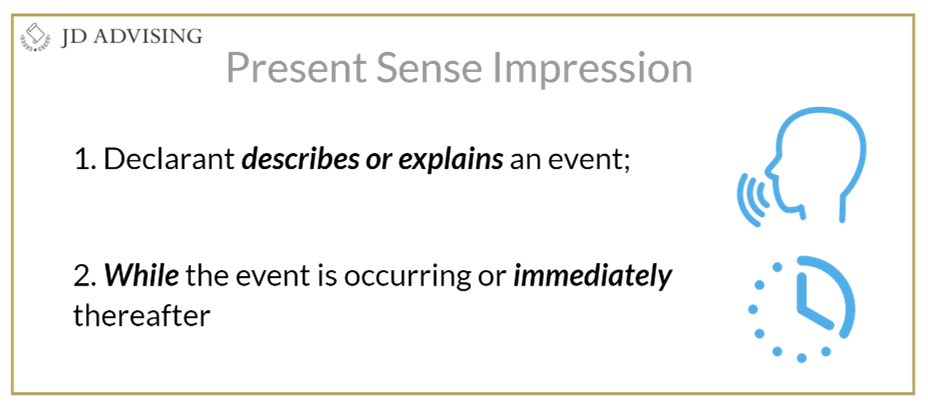
- Statement for purpose of medical treatment or diagnosis: these statements must be made for and be reasonably pertinent to a medical diagnosis or treatment and describe medical history, past or present symptoms or sensations, their inception, or their general cause.
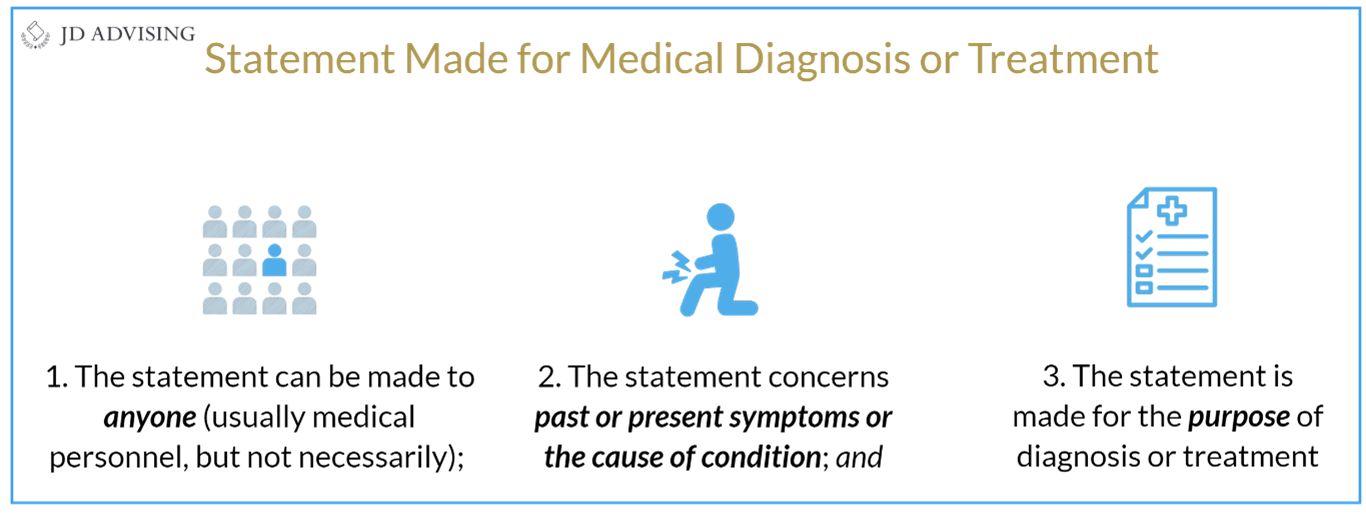
- Business records: A record of acts, events, conditions, opinions, or diagnoses is admissible if it is made at or near the time of the event recorded by a person with knowledge of the event . Further, the making of the record must occur in the course of a regularly conducted business activity , and it must be the regular practice of the business to make such a record.
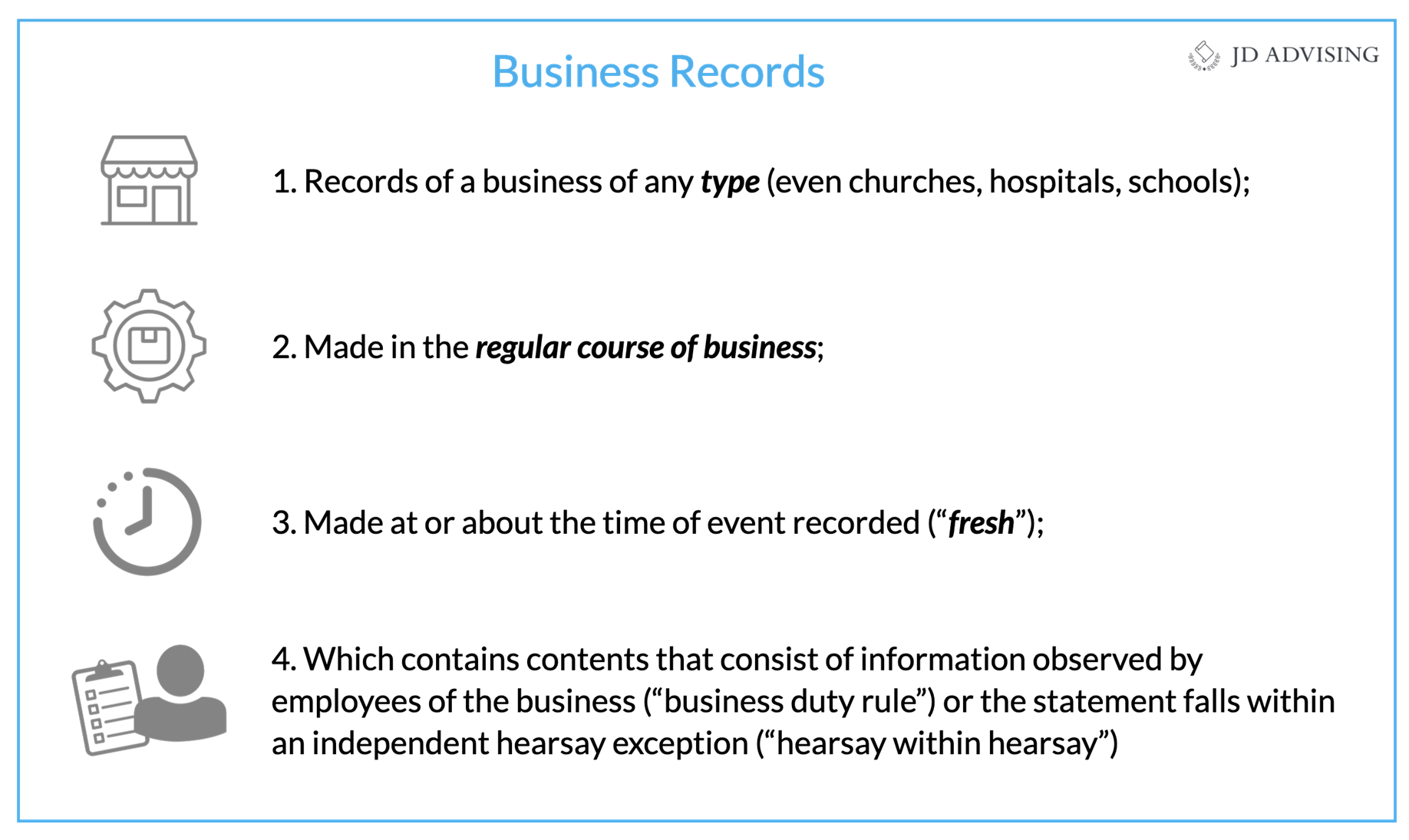
We recommend you make a list of (1) hearsay exclusions (nonhearsay), (2) hearsay exceptions that require the declarant be unavailable, and (3) hearsay exceptions where the declarant can be available or unavailable. Then, state each of the rules’ elements and memorize the elements. It is helpful to do this so you can keep the hearsay exclusions and exceptions straight and apply them properly when they are tested. Remember: If the statement is not hearsay, you do not need a hearsay exclusion!
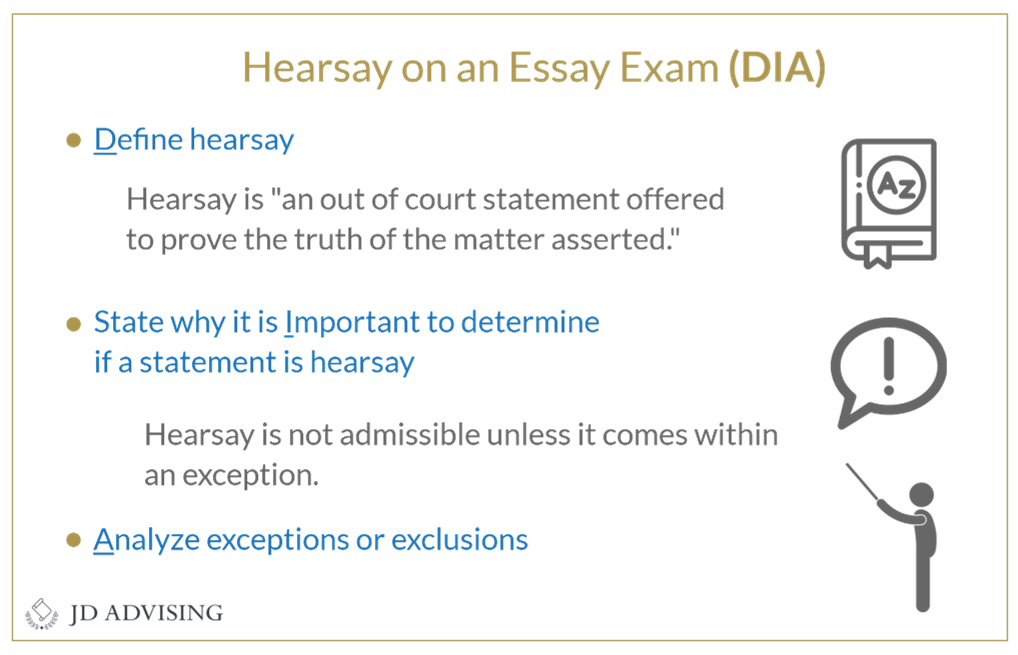
Impeachment
Impeachment is another topic that is tested frequently on the MEE. We recommend you memorize the seven ways to impeach a witness . Also, remember why impeachment evidence is being admitted. It is being admitted to show that the jury should not believe the witness .
- Prior inconsistent statement: Any prior inconsistent statement can be admitted to show that the jury should not believe the witness because the witness said something inconsistent in the past. (Note: extrinsic evidence is available in certain circumstances.)
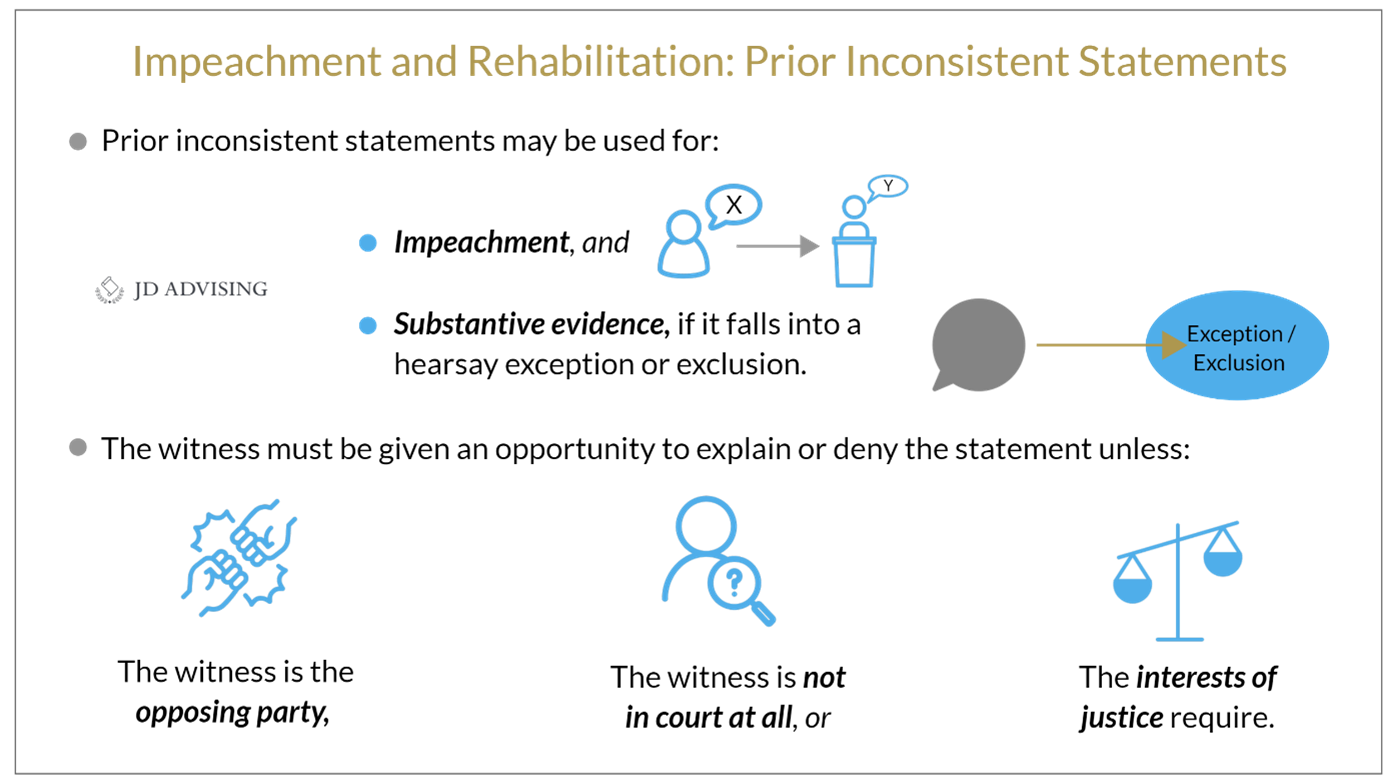
- Bias: Evidence of bias can be used to show that the jury should not believe the witness because they are biased (e.g., if a witness is testifying in favor of their mother!).

- Conviction of a crime: If a witness was convicted of a crime that meets certain requirements, the crime could be admitted to show that the jury should not believe the witness because the witness does not take the law seriously .
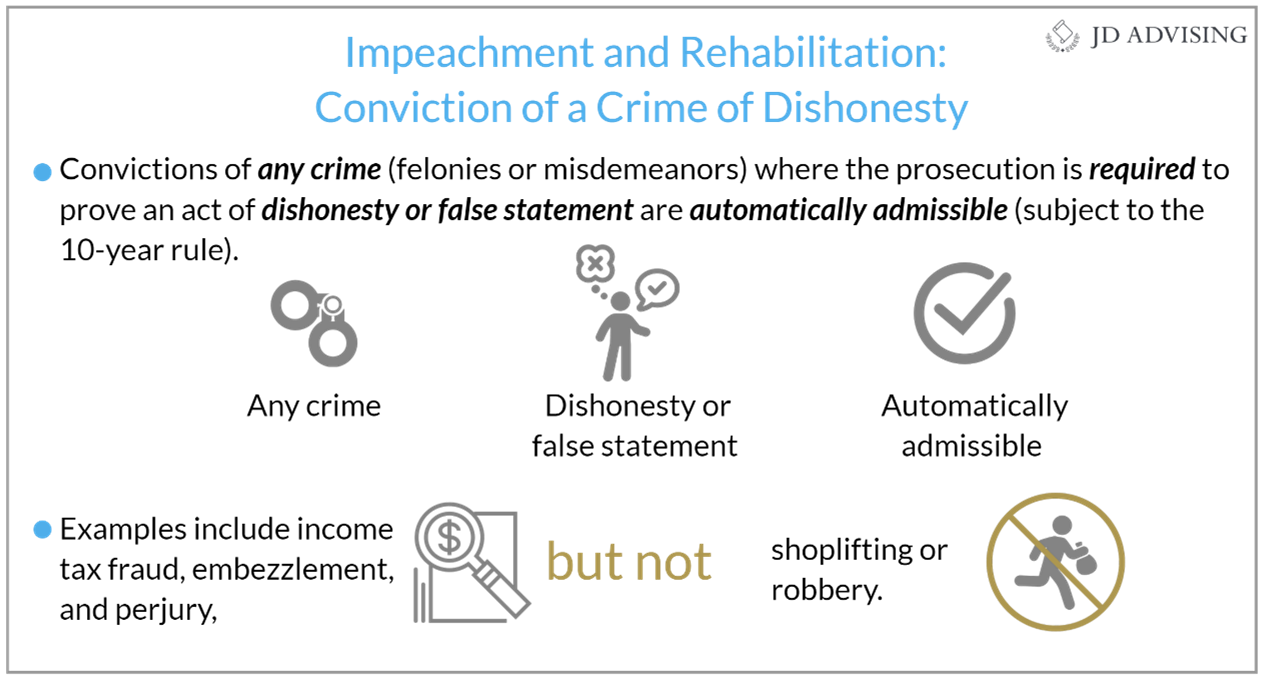
- Prior bad acts: These must relate to truthfulness . Essentially, if the witness did something, like cheat on the bar exam, (even if there was no “conviction”) it can be used to show that the jury should not believe the witness.

- Reputation or opinion for untruthfulness: If the witness has a reputation for being untruthful or if, in someone’s opinion , the witness is untruthful, this can be used to show that the jury should not believe the witness.

- Sensory deficiencies: if the witness is testifying about what they saw, for example, and the witness cannot see, this can be used to impeach the witness.
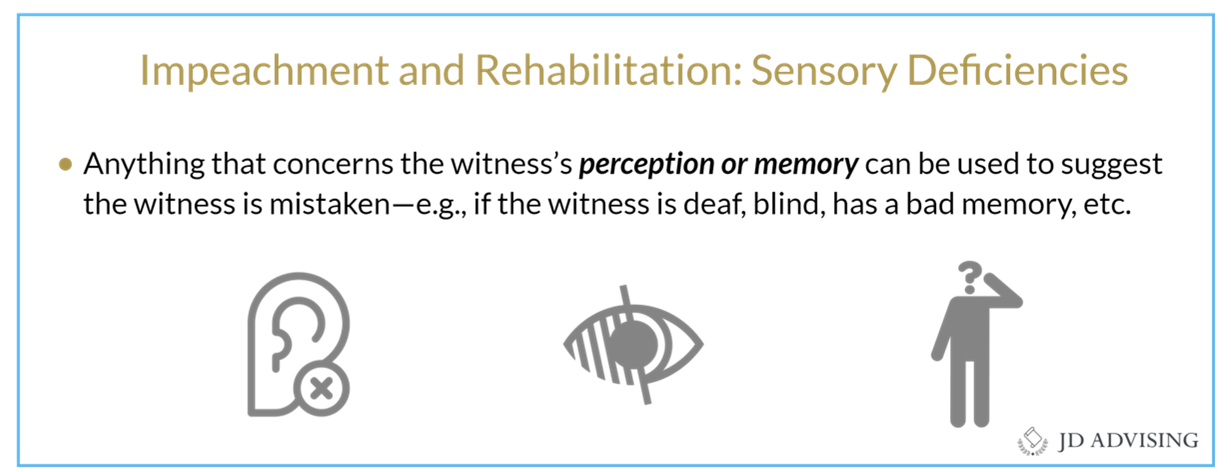
- Contradiction: If the witness made a mistake in their testimony , or lied , the witness may be contradicted . This may be used to show that the jury should not believe the witness.
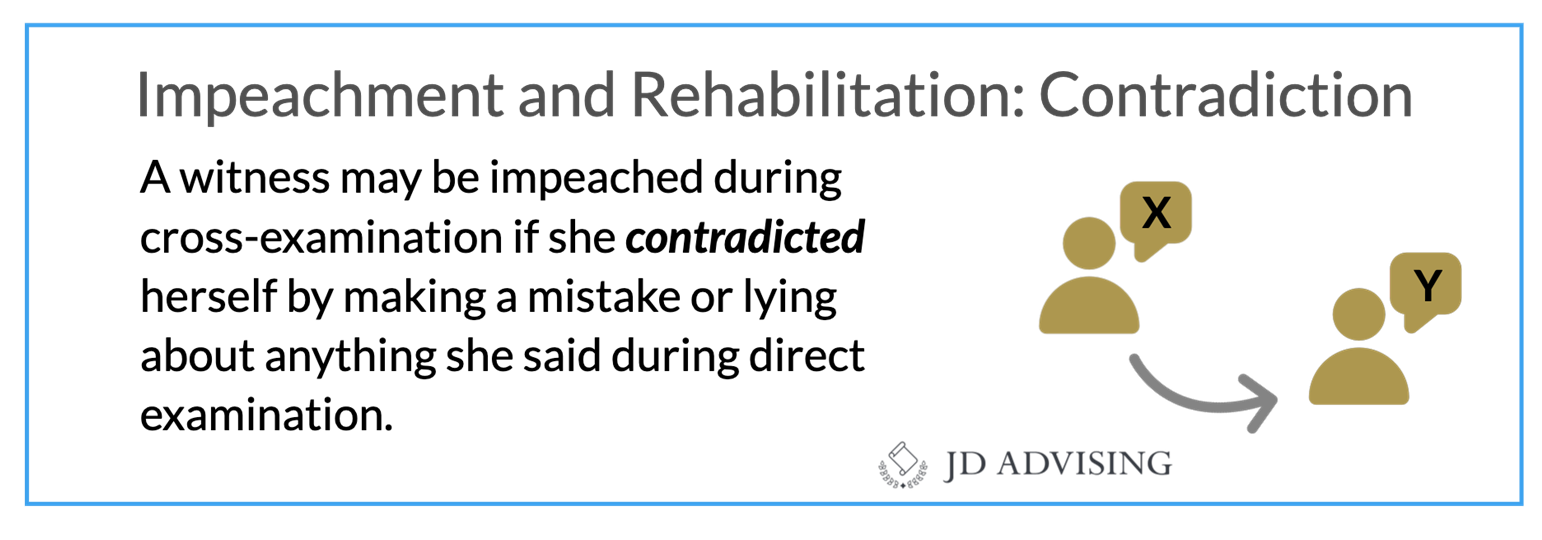
In addition to knowing these seven ways to impeach a witness, you want to learn the specific rules for each category of impeachment—including when extrinsic evidence can be offered and when the witness must be confronted on the stand. Always keep in mind why evidence is being offered as you learn the rules.
- Sixth Amendment Confrontation Clause: When approaching an MEE where a witness is unavailable in a criminal case , remember to discuss the Sixth Amendment Confrontation Clause, which provides the defendant the right to confront witnesses who testify against him .
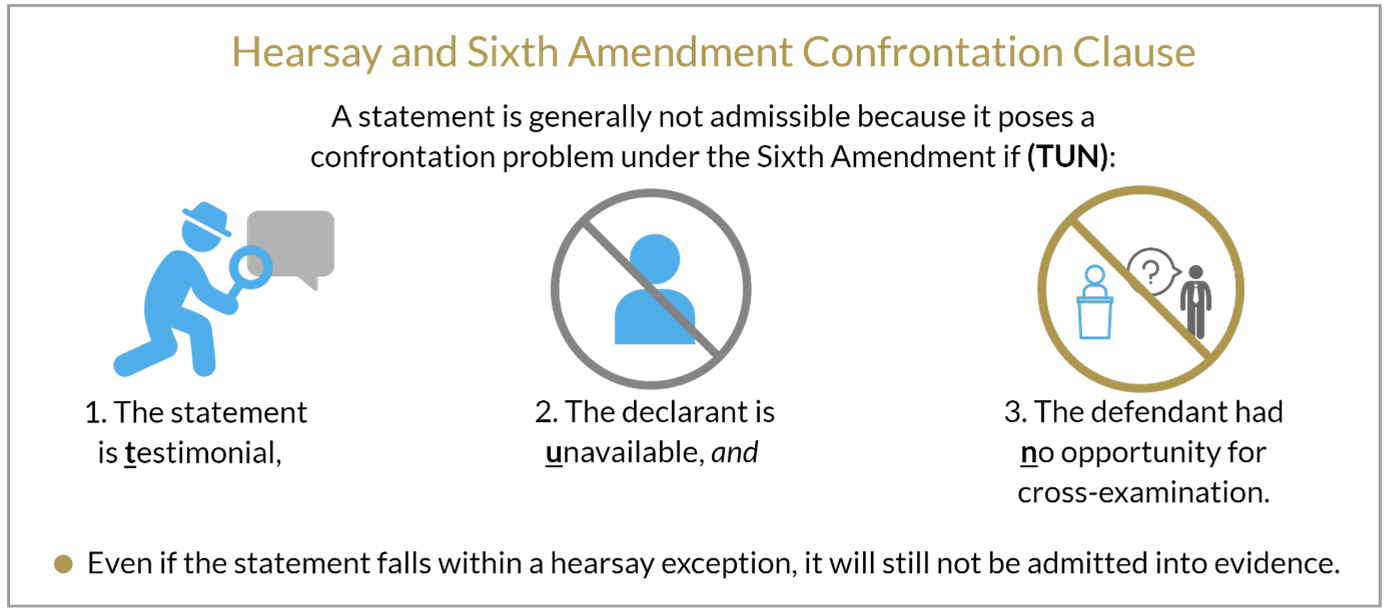
Other Evidence issues on the MEE
Other Evidence issues tested are character evidence , relevancy , policy exclusions , and witness testimony , among others. It is important to know Evidence well as you will need to have a solid understanding of Evidence for both the MEE and the MBE!
3. Make a visual map of why evidence is being offered
Often, we see students get confused and misapply rules because they apply a character evidence rule when impeachment is being tested. Or they apply a hearsay rule when a statement is not being offered for its truth.
If you struggle with this, remember to ask, “Why is the evidence being offered?” Once you have the answer to that question, you can apply the appropriate Evidence rules.
If evidence is being offered:
- To prove a statement was said, there is no hearsay issue. (Thus, you should consider nonhearsay purposes for offering a statement—e.g., effect on reader or listener.)
- To prove a statement is true, there is a hearsay issue.
- To show the jury that they should not believe a witness, there is an impeachment issue.
- To show a witness’s good or bad character, there is a character evidence issue.
- To show some other purpose (e.g., motive, intent, lack of mistake, identity, common scheme), there is a MIMIC issue.
4. Learn the basic definitions to introduce each set of rules
Many of the concepts in Evidence should be defined or introduced before you discuss them in an essay question. For example:
- Hearsay: hearsay is an out-of-court statement offered to prove the truth of the matter asserted.
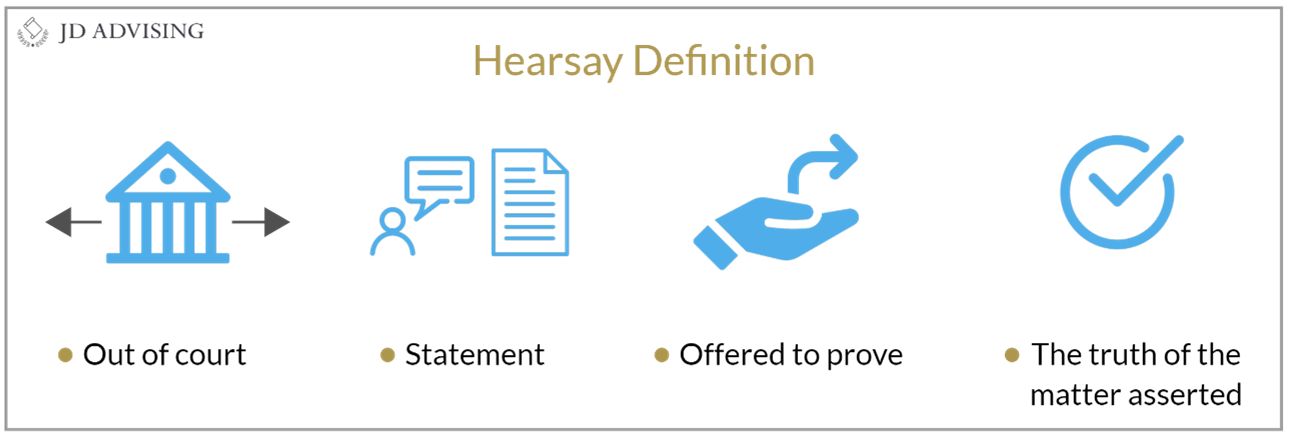
- Relevancy: Evidence is relevant if it has any tendency to make a fact more or less probable than it would be without the evidence, and the fact is of consequence in determining the action.
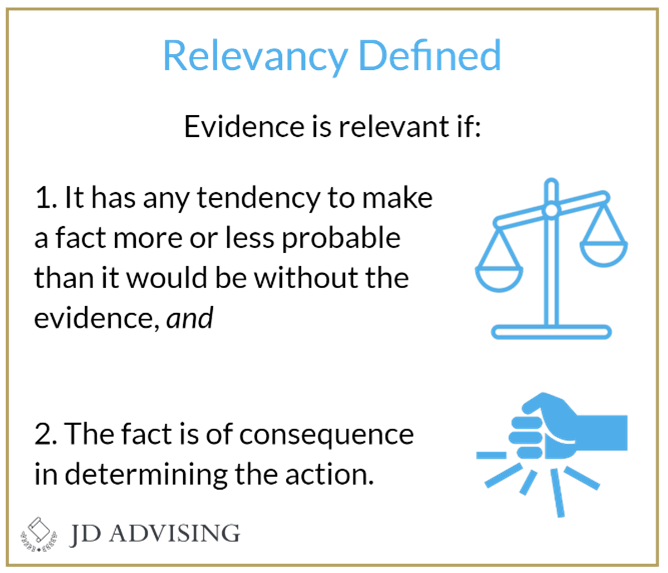
- Impeachment: generally, any party may impeach a witness.
- Character evidence: c haracter evidence generally is inadmissible to prove that a person acted in accordance with their character at the time the event occurred.
These are just some examples of how you may want to set up certain topics. Practicing past MEEs is a great way to see how the examiners prefer specific topics to be introduced.
5. Practice!
Practice is critical if you want to master Evidence on the MEE. As an added bonus, you may also see your MBE score improve if you practice writing answers to Evidence essays.
Here, we provide you with some links to free Evidence MEE questions and NCBE point sheets. (If you would like to purchase a book of Evidence MEE questions and NCBE point sheets, check out our MEE books here. You can also see some additional exams on the NCBE website for free here .)
- February 2023 Evidence MEE: this MEE covers admissibility of a statement made during a subsequently withdrawn guilty plea; former testimony of an unavailable witness; rule 401 relevancy; Rule 404 MIMIC (absence of mistake); 403 balancing test; and impeachment (prior acts of dishonesty)
- July 2022 Evidence MEE: this MEE covers expert witness testimony, character evidence (and MIMIC—motive), and relevance.
- February 2016 Evidence MEE: this MEE covers hearsay, the Sixth Amendment Confrontation Clause, and character evidence.
- July 2014 Evidence MEE: this MEE covers impeachment.
- July 2013 Evidence MEE: this MEE covers hearsay, hearsay exceptions, and the Sixth Amendment Confrontation Clause.
- February 2013 Evidence MEE: this MEE covers hearsay, hearsay exceptions, and relevancy.
Go to the next topic, Family Law .
Seeking mee expertise.
🌟 Freebies & Discounts
- Free Bar Exam Resource Center : Explore for leading guides, articles, and webinars.
- Expert-Crafted Bar Exam Guides : Unveil insights on high-frequency MEE topics and strategies for success.
- Free Webinars : Engage with top bar exam experts.
🔥 Top-Rated MEE Resources
- MEE One-Sheets : Boost your confidence with our most popular bar exam product!
- Bar Exam Outlines : Our comprehensive and condensed bar exam outlines present key information in an organized, easy-to-digest layout.
- NEW MEE Mastery Class : Unearth focused, engaging reviews of essential MEE topics.
- Bar Exam Crash Course and Mini Outlines : Opt for a swift, comprehensive refresher.
- MEE Private Tutoring and feedback : Elevate your approach with tailored success strategies.
- MEE Course : Preview our acclaimed five-star program for unmatched instruction, outlines, and questions.
🔥 NEW! Dive deep into our Repeat Taker Bar Exam Course and discover our unrivaled Platinum Guarantee Pass Program .
Related posts
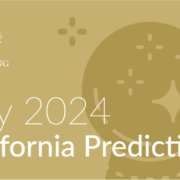

Leave a Reply
Your email address will not be published. Required fields are marked *
Save my name, email, and website in this browser for the next time I comment.
- Privacy Policy
- Terms of Use
- Public Interest
By using this site, you allow the use of cookies, and you acknowledge that you have read and understand our Privacy Policy and Terms of Service .
Cookie and Privacy Settings
We may request cookies to be set on your device. We use cookies to let us know when you visit our websites, how you interact with us, to enrich your user experience, and to customize your relationship with our website.
Click on the different category headings to find out more. You can also change some of your preferences. Note that blocking some types of cookies may impact your experience on our websites and the services we are able to offer.
These cookies are strictly necessary to provide you with services available through our website and to use some of its features.
Because these cookies are strictly necessary to deliver the website, refusing them will have impact how our site functions. You always can block or delete cookies by changing your browser settings and force blocking all cookies on this website. But this will always prompt you to accept/refuse cookies when revisiting our site.
We fully respect if you want to refuse cookies but to avoid asking you again and again kindly allow us to store a cookie for that. You are free to opt out any time or opt in for other cookies to get a better experience. If you refuse cookies we will remove all set cookies in our domain.
We provide you with a list of stored cookies on your computer in our domain so you can check what we stored. Due to security reasons we are not able to show or modify cookies from other domains. You can check these in your browser security settings.
We also use different external services like Google Webfonts, Google Maps, and external Video providers. Since these providers may collect personal data like your IP address we allow you to block them here. Please be aware that this might heavily reduce the functionality and appearance of our site. Changes will take effect once you reload the page.
Google Webfont Settings:
Google Map Settings:
Google reCaptcha Settings:
Vimeo and Youtube video embeds:
You can read about our cookies and privacy settings in detail on our Privacy Policy Page.

- Privacy Overview
- Strictly Necessary Cookies
This website uses cookies so that we can provide you with the best user experience possible. Cookie information is stored in your browser and performs functions such as recognising you when you return to our website and helping our team to understand which sections of the website you find most interesting and useful.
Strictly Necessary Cookie should be enabled at all times so that we can save your preferences for cookie settings.
If you disable this cookie, we will not be able to save your preferences. This means that every time you visit this website you will need to enable or disable cookies again.
myAU | AU Library | myWCL | Library Home | myLEAGLE Library Account

Pence Law Library Guides
Library Home | Research Guides | LEAGLE Catalog | E-Journals & Articles | Library Databases | Frequently Used Resources | Ask a Librarian
Bar Exam Information & Study Aids: Multistate Essay Examination (MEE)
- General Information
- Multistate Bar Examination (MBE)
- Multistate Essay Examination (MEE)
- Uniform Bar Examination (UBE)
- The Patent Bar
- Bar Exam Materials @ Pence
- International Examinees
- Studying for the Bar
Multistate Essay Exam

The Multistate Essay Examination (MEE) is developed by NCBE and consists of six 30-minute questions. It is administered by user jurisdictions as part of the bar examination on the Tuesday before the last Wednesday in February and July of each year.
The purpose of the MEE is to test the examinee’s ability to
- identify legal issues raised by a hypothetical factual situation;
- separate material which is relevant from that which is not;
- present a reasoned analysis of the relevant issues in a clear, concise, and well-organized composition; and
- demonstrate an understanding of the fundamental legal principles relevant to the probable solution of the issues raised by the factual situation.
The primary distinction between the MEE and the Multistate Bar Examination (MBE) is that the MEE requires the examinee to demonstrate an ability to communicate effectively in writing. More information is available from NCBE here
Study Aids for the MEE
MEE Questions and Analyses from Recent Administrations
NCBE publishes study aids for the MEE that include questions from previously administered tests and model analyses that are illustrative of the discussions that might appear in excellent answers to the questions. They are available for purchase at the NCBE Study Aids Store .
For the six MEE questions administered in July 2018 (without analyses), see Sample Questions .
MEE Questions and Analyses from Older Administrations
MEE Questions and Analyses from older administrations are available by accessing the following files. July 2014 February 2014 July 2013 February 2013 July 2012 February 2012 July 2011 February 2011 July 2010 February 2010 July 2009 February 2009 July 2008 February 2008
Essay Assistance
- Compilation of bar examination questions and answers by Institute for Bar Review Study Call Number: Bar Exam Materials - 1st Floor | KF303 .I5 Contains various states' essay examinations.
- << Previous: Multistate Bar Examination (MBE)
- Next: MPT >>
- Last Updated: Apr 17, 2024 11:15 AM
- URL: https://wcl.american.libguides.com/barexam

Bar Exam Resources
- State Specific Bar Exam Resources
- MPRE (Multistate Professional Responsibility Examination)
- Uniform Bar Examination (UBE)
- MBE (Multistate Bar Examination)
Multistate Essay Examination (MEE)
- MPT (Multi-State Performance Test)
- NextGen Bar
- Accessing Databases & E-Resources
- Law Library Useful Links
- Get Help & About the Author
- Feedback on this Guide
The Multistate Essay Examination (MEE) is a collection of 30-minute essay questions and is administered by participating jurisdictions on the Tuesday before the last Wednesday in February and July of each year. The MEE offers nine questions per examination, with most jurisdictions selecting six questions from the nine. Ohio does not administer the MEE but other states, including Kentucky, do.
- MEE Information
- Sample Questions from the July 2023 exam are available on the NCBE web site.
- February 2018
- February 2017
- February 2016
- February 2015
- February 2014
- << Previous: MBE (Multistate Bar Examination)
- Next: MPT (Multi-State Performance Test) >>
- Last Updated: May 13, 2024 7:25 AM
- URL: https://guides.libraries.uc.edu/barexam
University of Cincinnati Libraries
PO Box 210033 Cincinnati, Ohio 45221-0033
Phone: 513-556-1424
Contact Us | Staff Directory
University of Cincinnati
Alerts | Clery and HEOA Notice | Notice of Non-Discrimination | eAccessibility Concern | Privacy Statement | Copyright Information
© 2021 University of Cincinnati

Bar Exam Success Guide
Introduction.
- State Specific Bar Exam Resources
- Georgia Bar Exam
- Uniform Bar Examination (UBE)
- Multi-State Essay Exam (MEE)
Subjects Tested
Mee study aids.
- Georgia Essays
- Next Gen Bar
- Financial Expectations
- Mindfulness
The Multistate Essay Examination (MEE) is a component of the Uniform Bar Examination. If you are taking the Georgia bar, and thus not the UBE, please refer to the Georgia Essays page for relevant information.
The MEE consists of six 30-minute questions. Developed by NCBE, the MEE is administered by user jurisdictions as part of the bar examination on the Tuesday before the last Wednesday in February and July of each year.
The MEE is only one of a number of measures that a board of bar examiners may use in determining competence to practice. Each jurisdiction grades the MEE and determines its own policy with regard to the relative weight given to the MEE and other scores. Jurisdictions that administer the Uniform Bar Examination weight the MEE component 30%.
Instructions for taking the MEE can be found here .
The NCBE website has old MEE questions and analyses from July 2013 until February 2018 available for reference.
- << Previous: MBE
- Next: Georgia Essays >>
- Last Updated: May 13, 2024 10:35 AM
- URL: https://libguides.law.gsu.edu/barexamsuccess

- California Essays
- California Performance Test
- Multistate Essay Exam
About the MEE
- Multistate Performance Test
- Subject-Specific
- Strategy and Planning
- Study Spaces
- Wellness Resources
- Password Q&A
Note that Effective with the July 2026 bar exam, the following areas will no longer be tested on the MEE: Conflict of Laws, Family Law, Trusts and Estates, and Secured Transactions.
- NCBE Info on the MEE Information on the essay portion of the UBE provided by the NCBE.
- MEE Released Questions The NCBE releases MEEs from past administrations of the exam. The questions are at the bottom of the webpage.
- << Previous: Uniform Bar Exam
- Next: Multistate Performance Test >>
- Last Updated: May 14, 2024 2:22 PM
- URL: https://libguides.law.uci.edu/barprep

- Grading the NextGen Field Test: Two Graders’ Thoughts on the NextGen Bar Examination
This article originally appeared in The Bar Examiner print edition, Spring 2024 (Vol. 93, No. 1), pp. 65-67. By Geoffrey R. Bok; Carole Wesenberg
In early 2024, NCBE had 4,124 participants from 88 law schools in 41 jurisdictions take part in a nationwide field test for the NextGen bar exam. The field test helped NCBE gather feedback and data on new question types, test the computer-based delivery system, and refine timing estimates. Jurisdiction graders also had the opportunity to gain experience in grading the new exam. Two graders share their insights on the process below.
Extensive Grading Materials and High-Quality Questions: The NextGen Bar Exam Ensures Thorough Assessment and Grader Uniformity
By Geoffrey R. Bok I have been grading bar examinations since 1989, first in Massachusetts and later in Vermont—each of which first administered the Uniform Bar Exam in July 2018 and July 2016, respectively. I have written and graded state law essay questions, and graded the Multistate Essay Examination, the Multistate Performance Test (MPT), and the earlier 2023 NextGen pilot test. Based on this, I was asked to be a grader for six questions during the recent field test of the NextGen bar exam.
NCBE’s training for grading the NextGen field test was extensive. Each question came with a comprehensive document that contained the full text of the question, along with related materials that had been given to examinees (such as relevant legal documents, court decisions, newspaper articles, affidavits, and transcripts of client interviews). These materials also provided the grader with a detailed and clear list of the points a correct answer would make, as well as a list of incorrect answers. Many sample answers were included, as were extensive summaries of what score each of these sample answers should receive. Finally, graders watched a separate on-demand video for two of the questions, in which an expert went over how to score answers to each question.
The first type of question I graded required the examinee, acting as an attorney in a matter, to provide two short responses based on the factual (and sometime legal) information provided to them. For example, such responses could be in terms of what the attorney should do next in representing their client, what arguments to make to the opposing side to try to settle the case favorably, what discovery to request, and/or what facts are adverse or helpful to their client. Sometimes a question had more than two correct answers, but the examinee got full points by identifying two correct answers and half the total points for only identifying one correct answer. On the questions of this type that I graded, it forced the examinee to review a somewhat complex set of facts and then use their legal skills and knowledge to respond briefly to a specific inquiry for two pieces of information or future action.
The other type of question I graded was similar to a shorter version of the current MPT, in that it gave the examinee the law and facts needed to write a legal document (e.g., a legal memorandum to a judge in support of a client’s motion or revisions to a draft contract). Answers that received the most points found the applicable legal standards in the provided materials, found the most helpful facts in the provided facts to apply to these legal standards, and then brought them together in a document that did not misstate either the law or the facts. Some of these questions were longer than others, so examinees were tasked with writing documents of different lengths and levels of complexity.
There also were some multiple-choice questions, but these did not appear to need a human grader to score them. These multiple-choice questions appeared both within each item set of short-answer constructed-response questions and as standalone items.
I have a few observations based on my experience grading the NextGen field test. First, in all my years of grading bar examinations, I have never been so impressed with the scope and detail of the provided grading materials and resources. Access to such extensive grading materials should ensure that grading a NextGen answer is both accurate and uniform from grader to grader. For instance, for NextGen, two graders will grade each response, and when the grades are not within a set tolerance, they will receive a third grade from a grading leader or more senior grader. Next, I found that the exam’s questions, and the answers they sought, appeared to test an examinee’s legal knowledge and skills in a very fair, thorough, and thoughtful manner. Furthermore, the factual patterns (and types of questions asked based on these factual patterns) reflected real legal problems and tasks that a newly licensed lawyer would face.
Based on this field test grading, and on my many years as a grader and a bar examiner, I am excited to see the NextGen bar exam move from this stage to implementation.

Ensuring Progress: The NextGen Bar Exam Improves Lawyer Skills Testing and Grader Consistency
By Carole Wesenberg Change does not necessarily assure progress, but progress implacably requires change.” — Henry Steele Commager 1
Over the past two decades, I have graded the bar exam in Idaho 36 times. The exam has certainly changed over this time, including via adoption of the Uniform Bar Exam (UBE) in March 2011. Idaho is now exploring whether to adopt the NextGen bar exam.
Besides grading the bar exam, I have attended NCBE conferences and workshops; worked with the Idaho State Bar regarding the grading process; and, most recently, served on Idaho’s NextGen Bar Examination Task Force. To better understand the grading-process changes that would be necessary in Idaho due to the new exam, I volunteered and was selected to grade the NextGen field test.
After grading the NextGen field test, I was struck by the progress made in ensuring that the new exam provided a better assessment of the real-world skills and knowledge necessary to be a competent attorney. Examinees still need to know and understand the law. However, they no longer have to memorize, for example, the doctrinal minutiae of every complex or nuanced legal topic. Instead, for some questions examinees must identify what legal research to undertake, what facts are important, and/or what their clients need to know.
Although the grading process may not be front of mind for most stakeholders, for longtime graders like me, grading the high-stakes bar exams is an enormous responsibility. Graders need to ensure fairness to both examinees and the public. And, because of the UBE’s score portability, a benefit that continues with the NextGen exam, it’s important that one jurisdiction’s grading standards do not significantly differ from another’s.
Over my years of grading, I have thought a lot about best practices to ensure fairness and consistency. However, the challenge with the Multistate Essay Examination (MEE) and the Multistate Performance Test (MPT) is that it is impossible to entirely eliminate the subjectivity that can come with grading essay questions. NCBE provides a lot of resources through rubrics, model answers, and workshops to help calibrate exam answers. However, grading consistency remains a challenge requiring both awareness and vigilance.
The NextGen bar exam eliminates many of my concerns regarding grading and consistency. It directs examinees to provide written answers to address specific tasks in a practice-oriented context, such as identifying errors in a contract or interpreting a provided statute. These tasks require examinees to provide concise and focused responses compared to the more open-ended format of the MEE. These changes help ensure that grading will be more objective, fair, and uniform within and throughout jurisdictions.
NCBE has done an excellent job of making the graders’ job more straightforward. The NextGen bar exam includes integrated question sets and performance tasks; NCBE provides a grading rubric, grading notes, and benchmarks for these test items. The materials were generally thorough and easy to apply. In particular, the benchmarks provided model answers and examples of partially correct and incorrect answers, taking a substantial amount of guesswork out of determining the proper number of points to assign to an answer.
Integrated question sets are geared to quickly assess an applicant’s ability to analyze, synthesize, or evaluate the information provided. The sets I graded called for two or four correct answers per question, and those answers were limited to one or two sentences; answers were graded on a two-point scale. I found the grading less time-consuming and, more importantly, easier to discern the differences between the answers. Relative grading or rank-ordering were no longer in play. In short, grading was simplified: the answer was correct, partially correct, or incorrect.
Performance tasks were similarly more straightforward to grade. They are more akin to the current MPT; however, each question’s call was narrowly tailored to assess an applicant’s skills in legal research and written legal analysis. Thus, instead of reviewing a lengthy answer typical of an MPT, performance task answers were shorter and more focused. In the task I graded, the rubric was not broken down holistically by issue but rather via a familiar IRAC/CREAC format, 2 with each element graded on a two-point scale and another two-point assessment for the overall answer organization. Although I might question whether a conclusion element should be weighed the same as a rule or application element, I am pleased that many subjective components have been eliminated. And I expect NCBE to refine the grading process further in the future.
All in all, the changes present in the NextGen bar exam ensure progress on two fronts. First: it is a better test of lawyering skills. Competent representation does not require mere memorization of the law. Nor would we expect newly licensed attorneys to rely solely on their memory; to do so would constitute malpractice. A licensure exam should test for the skills a profession requires. Second: the NextGen bar exam has a more objective, fair, and consistent grading format. Graders can be more confident in the validity and reliability of the grading process for both the applicants and the public. These are the strengths of the NextGen bar exam, and I am excited about the changes and progress to come.
- Henry Steele Commager, “We Have Changed—and Must,” New York Times (April 30, 1961), at 77, available at https://www.nytimes.com/1961/04/30/archives/we-have-changed-and-must-a-historian-reviews-the-profound.html . (Go back)
- IRAC (Issue, Rule, Analysis, Conclusion) or CREAC (Conclusion, Rule, Explanation, Analysis, Conclusion) are two methods for organizing specific legal issues. (Go back)

Contact us to request a pdf file of the original article as it appeared in the print edition.
In This Issue
Spring 2024 (Vol. 93, No. 1)
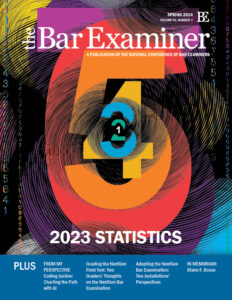
- Letter from the Chair
- President’s Page
- Facts & Figures
2023 Statistics
- How Generative Artificial Intelligence Made “Hallucinate” Cambridge Dictionary’s 2023 Word of the Year
- From My Perspective: Coding Justice: Charting the Path with AI
- The Next Generation of the Bar Exam: Adopting the NextGen Bar Examination: Two Jurisdictions’ Perspective
- Quarterly Update: NextGen Development Forges Ahead with Prototype Exam on the Horizon
- The Testing Column: Grading the MEE, MPT, and the NextGen Bar Exam: Ensuring Fairness to Candidates
- FAQs About Bar Admissions: I passed the bar exam! When can I call myself a lawyer?
- News & Events
- In Memoriam: Diane F. Bosse
- In the Courts
Bar Exam Fundamentals
Addressing questions from conversations NCBE has had with legal educators about the bar exam.
Online Bar Admission Guide
Comprehensive information on bar admission requirements in all US jurisdictions.
NextGen Bar Exam of the Future
Visit the NextGen Bar Exam website for the latest news about the bar exam of the future.
BarNow Study Aids
NCBE offers high-quality, affordable study aids in a mobile-friendly eLearning platform.
2023 Year in Review
NCBE’s annual publication highlights the work of volunteers and staff in fulfilling its mission.
Bar examination and admission statistics by jurisdiction, and national data for the MBE and MPRE.

IMAGES
VIDEO
COMMENTS
February 21, 2023. July 25, 2023. Succeeding on the Multistate Essay Examination (MEE) is an essential step toward becoming a lawyer in most states. Learn more about the exam format, tested subjects, registration, and other crucial details.
Free MEE Questions and Analyses from Older Administrations. MEE Questions and Analyses from older administrations are available by accessing the following files. Find guidance and resources to help you prepare for the MEE.
In addition to the state-specific essays many jurisdictions include in their exams, the Multistate Essay Exam (MEE) is an integral part of the Bar in 33 jurisdictions and 5 U.S. Territories. Not only does the MEE draw questions from MBE subjects—Contracts, Constitutional Law, Criminal Law/Procedure, Evidence, Torts, and Real Property—it ...
Looking for information on the MEE®? Here's everything you need to know about the Multistate Essay Exam eligibility, format and topics, passing score, and results.
The Multistate Essay Exam consists of six questions. You are given three hours to answer the questions, which means you should allocate about 30 minutes per question to finish the exam on time. If you are in a UBE jurisdiction, the MEE is worth 30% of your score.
The Multistate Essay Exam tests your knowledge of rules and your ability to write well written essays. You can pass this portion of the Uniform Bar Exam by making sure that you memorize the most frequently tested questions, review past essays, and practice writing clear and comprehensive answers to bar exam essay questions.
While the multistate essay exam will test six essay questions, there are actually 14 potential subjects that it could test. Further, occasionally, one essay will test more than one subject (e.g., a subject like Civil Procedure will be combined with a subject like Conflicts of Law).
The National Conference of Bar Examiners has produced the Multistate Essay Examination (MEE) since 1988. The MEE consists of six 30-minute questions per administration. The purpose of the MEE is to test the examinee’s ability to (1) identify legal issues raised by a hypothetical factual situation; (2) separate material which is relevant from ...
Evidence on the Multistate Essay Exam: Highly Tested Topics and Tips. Evidence is regularly tested on the MEE. Here, we give you tips for approaching Evidence on the MEE and we reveal some of the highly tested issues in Evidence questions.
The Multistate Essay Examination (MEE) is developed by NCBE and consists of six 30-minute questions. It is administered by user jurisdictions as part of the bar examination on the Tuesday before the last Wednesday in February and July of each year.
The Multistate Essay Examination (MEE) consists of six 30-minute questions. Developed by NCBE, the MEE is administered by user jurisdictions as part of the bar examination on the Tuesday before the last Wednesday in February and July of each year.
The Multistate Essay Examination (MEE) is a collection of 30-minute essay questions and is administered by participating jurisdictions on the Tuesday before the last Wednesday in February and July of each year. The MEE offers nine questions per examination, with most jurisdictions selecting six questions from the nine.
The Multistate Essay Examination (MEE) is a component of the Uniform Bar Examination. If you are taking the Georgia bar, and thus not the UBE, please refer to the Georgia Essays page for relevant information. The MEE consists of six 30-minute questions.
Upcoming MBE Dates: February 22, 2023. Passing the Multistate Bar Examination (MBE) is an essential step toward becoming a lawyer in most states. Learn more about the exam format, tested subjects, registration, and other crucial details.
The Multistate Essay Examination (MEE) is developed by the National Conference of Bar Examiners (NCBE). This publication includes the questions and analyses from the February 2018 MEE. (In the actual test, the questions are simply numbered rather than being identified by area of law.) The instructions for the test appear on page iii.
Note that Effective with the July 2026 bar exam, the following areas will no longer be tested on the MEE: Conflict of Laws, Family Law, Trusts and Estates, and Secured Transactions.
The National Conference of Bar Examiners has produced the Multistate Essay Examination (MEE) since 1988. The MEE consists of six 30-minute questions per administration. The purpose of the MEE is to test the examinee’s ability to (1) identify legal issues raised by a hypothetical factual situation; (2) separate material which is relevant from ...
I have written and graded state law essay questions, and graded the Multistate Essay Examination, the Multistate Performance Test (MPT), and the earlier 2023 NextGen pilot test. Based on this, I was asked to be a grader for six questions during the recent field test of the NextGen bar exam.